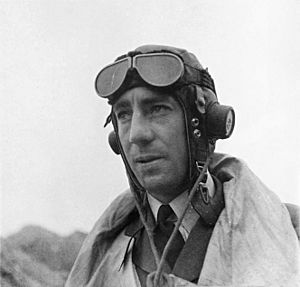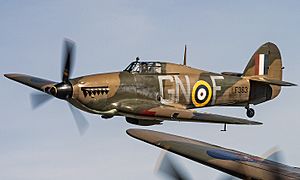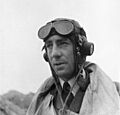Minden Blake facts for kids
Quick facts for kids
Minden Blake
|
|
|---|---|
 |
|
| Born | 13 February 1913 Eketāhuna, New Zealand |
| Died | 30 November 1981 (aged 68) Surrey, England |
| Allegiance | New Zealand |
| Service/ |
Royal Air Force |
| Years of service | 1936–1958 |
| Rank | Wing Commander |
| Commands held | No. 238 Squadron No. 234 Squadron Exeter (Polish) Wing Portreath Wing |
| Battles/wars | Second World War
|
| Awards | Distinguished Service Order Distinguished Flying Cross Mentioned in despatches (2) |
Minden Vaughan Blake (13 February 1913 – 30 November 1981) was a brave New Zealand flying ace who served in the Royal Air Force (RAF) during the Second World War. He was officially credited with shooting down 10 enemy aircraft.
Born in Eketāhuna, New Zealand, Blake studied science at Canterbury University College. In 1936, he joined the RAF. He played an important part in the Battle of Britain in 1940, leading No. 238 Squadron and later No. 234 Squadron. During this time, he destroyed several German bombers. He received the Distinguished Flying Cross in January 1941 for his bravery. By mid-1942, he was in charge of a group of fighter squadrons. He was shot down during a mission supporting the Dieppe Raid and became a prisoner of war. Just days before, he had been awarded the Distinguished Service Order.
After the war, he continued to serve in the RAF until 1958. Later, he became a clever inventor, creating a successful golfing aid. He passed away in 1981 at 68 years old.
Contents
Early Life and Education
Minden Vaughan Blake was born in Eketāhuna, New Zealand, on 13 February 1913. His father, Charles Minden Blake, was a schoolmaster.
Minden went to Southland Boys' High School and then Christchurch Boys' High School. He loved sports, playing cricket and soccer, and competing in athletics. He became the national champion in pole vault in 1936.
In 1932, Blake started studying at Canterbury University College. He earned a Bachelor of Science degree three years later. His father helped pay for his studies by buying a chicken farm. Blake even invented technology to help sort eggs! After graduating, he continued his studies in mathematics. He also worked as a physics lecturer at the university. In 1936, he decided to join the Royal Air Force (RAF).
Joining the Royal Air Force
Blake's application to the RAF was accepted, and he traveled to England in November 1936. He began his flying training in December at Brough Aerodrome in Yorkshire.
In March 1937, he officially became a pilot officer in the RAF. He then went to RAF Sealand for more training. He earned his pilot's wings in June and was chosen to train on fighters. He learned to fly the Hawker Fury biplane. A few months later, he joined No. 17 Squadron, flying Gloster Gauntlet planes from Kenley.
In September 1937, Blake was promoted to flying officer. He became one of No. 17 Squadron's flight commanders. In March 1939, he was promoted again to flight lieutenant. The squadron later moved to North Weald and started flying Hawker Hurricane planes. Blake continued his pole vaulting, becoming the RAF champion three years in a row from 1937 to 1939.
Second World War Missions
When the Second World War began, No. 17 Squadron was based at Croydon. On 8 September, Blake had a minor accident. His Hurricane's engine failed during a landing attempt. He crashed into the grounds of Purley Hospital. His plane clipped a chimney he couldn't see in the dim light, causing it to flip. He was bruised and had a cut on his head. The engine failure was caused by hay from the airfield grass getting into the air intake.
For the first few months of the war, the squadron flew defensive patrols. In April 1940, Blake became an instructor at No. 10 Flying Training School. After four months, he was sent to No. 238 Squadron at RAF St. Eval in Cornwall. He became its acting commander on 16 August. His squadron was part of No. 10 Group, which protected southwest England.
Battle of Britain Heroics
Soon after arriving, Blake shot down his first enemy plane, a Junkers Ju 88 bomber, on 21 August. A few days later, he helped destroy a Dornier Do 17 bomber. In September, No. 238 Squadron moved to RAF Middle Wallop. This base was closer to London, so they began helping to defend southeast England. On 14 September, he destroyed another Ju 88 over Brooklands.
The next day, known as Battle of Britain Day, No. 238 Squadron was sent to protect London from a large bombing raid. Blake led his squadron against Heinkel He 111 bombers over Kenley. He claimed one He 111, which crashed on an airfield in Sussex. His own plane was damaged, and he had to make an emergency landing nearby.
Later that month, Blake was promoted to acting squadron leader. He took command of No. 234 Squadron. This squadron was also part of No. 10 Group and operated from Middle Wallop. On 24 November, Blake helped shoot down a Dornier Do 215 bomber. At the end of the month, his squadron protected the destroyer HMS Javelin as it sailed into Plymouth. German Do 17 bombers attacked Javelin, but Blake shot down one bomber and damaged another.
Channel Front Missions (1941–42)
In January 1941, Blake was awarded the Distinguished Flying Cross. His squadron then moved to Dorset and started flying Supermarine Spitfire Mk IIa planes. They began flying offensive missions over occupied France and Belgium. On 11 March, he helped destroy a Messerschmitt Bf 109. He was also mentioned in despatches for his leadership.
Blake shot down a Ju 88 in May 1941, and a Bf 109 a few days later. On 10 July, while escorting Bristol Blenheims, his squadron was attacked by Bf 109s. He destroyed two of them, but his Spitfire was damaged. He had to ditch his plane in the English Channel. He managed to escape and inflate his emergency dinghy. After several hours, an Air Sea Rescue Services boat picked him up.
In August, Blake briefly commanded a fighter wing of Polish squadrons from RAF Exeter. On 21 September, he became wing leader at RAF Portreath. In October, he led a wing of Spitfires covering a bombing raid on St. Omer. By the end of the year, he was promoted to acting wing commander.
Blake continued leading missions. He also helped develop a special gyroscopic gunsight for fighters.
The Dieppe Raid and Capture
On 19 August 1942, Blake led his wing to support the Dieppe Raid. They encountered Focke Wulf Fw 190s. Blake destroyed one Fw 190, but his own plane was damaged. A cannon shell shattered his canopy, sending plastic shards into his eyes. He ditched his Spitfire in the English Channel, near the French coast, and got into his emergency dinghy. Despite his eye injuries, he paddled towards England. He spent almost a day in the dinghy before a German rescue boat found him. He became a prisoner of war (POW). He was the highest-ranking RAF officer captured during the Dieppe Raid. By this time, he had shot down at least ten enemy aircraft.
Life as a Prisoner of War
Because of his eye injuries, Blake was hospitalized in France for three weeks. He was then transported to Germany by train. During the journey, he jumped from a train window, injuring his hand and head. He found a French farmhouse for help. However, the farmer, worried for his family's safety, turned him over to the German authorities.
Blake spent most of the rest of the war at Stalag Luft III, a POW camp in Sagan, Germany. By 1943, he was the senior RAF officer in charge of Block 104. There, he met Leonard Trent, another New Zealander and RAF POW. Trent taught Blake how to play golf using a homemade ball and club. In return, Blake taught Trent gymnastics, even building parallel bars. In January 1945, as Soviet forces advanced, the POWs at Stalag Luft III were forced to march west to another camp. They were moved again in April but were freed by the British on 2 May.
After the War
After the war, Blake spent several months on leave in New Zealand. He met and married Molly Seldon from Christchurch. They returned to England for him to continue his RAF career. In early 1946, he worked at Fighter Command headquarters. In February, King George VI presented him with his DSO medal at Buckingham Palace.
He was mentioned in despatches again in early 1947 and attended a course at the RAF College. His next role was at Transport Command headquarters. He remained interested in golf and continued his pole vaulting career. He was RAF champion again in 1946 and from 1948–1949. He was even considered for the British track and field team for the 1948 Summer Olympics.
In 1950, Blake moved to personnel duties for Bomber Command. He then worked for the North Atlantic Treaty Organization (NATO) in Oslo, Norway. While in Oslo, he won Norway's Amateur Golf Championship. His final role in the RAF was in planning at the Air Ministry. He retired from the military in January 1958.
Later Life and Inventions
After leaving the military, Blake first worked as a manager in a car wax factory. He then moved to Swansea to work in a textile factory. He eventually settled in Surrey, working for an electronics company.
Blake loved to tinker and built a workshop at his home. He soon invented a golfing aid called the 'Swingrite'. He received a patent for it in 1965. The 'Swingrite' was very successful and made him financially comfortable. He also wrote books about golfing techniques and promoted a new golf swing style. A few years later, he received a patent for a safety-belt mechanism for vehicles.
Minden Blake passed away on 30 November 1981. There is a memorial to him at Purley Hospital, where he crashed his Hurricane early in the Second World War. The memorial describes the accident.
Images for kids



